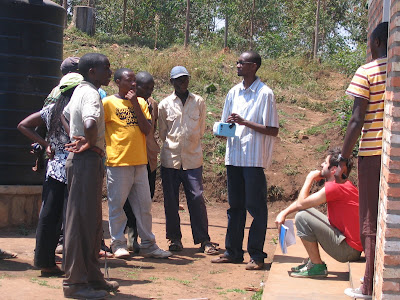Early last morning the team left for the North for a one-day expedition to Minazi. It was a somewhat emotional trip for Mansoor, Chris and Laurent: a year ago, almost to the day, they had first arrived in Rwanda as part of e.quinox to set up an experimental, non-profit energy kiosk in the most remote and unequipped village they could find. That village was Minazi.
We packed in a large jeep with Simon, a student from the Kigali Institute of Science and Technology (KIST) involved with the e.quinox project, and Clara and Okito, both members of the Belgian Technical Corporation (BTC). After a quick hour's drive on paved roads, the car branched off into a meandering dirt track that seemed to plunge down into the trees. The three of us who had to sit in the trunk were in for an uncomfortable ride: the second half of the drive to Minazi was bumpy, winding, and often bruise-inducing (not to mention the clouds of dust that swirled in the car each time we took a turn or crossed paths with another vehicle). It took us another hour to reach Minazi.
The trip was worth it, though. If only because, at 2400 meters of altitude, Minazi is a beautiful location, a summit from which one can admire a 360° panorama of Rwanda's thousand hills. The village itself is barely more than a loose cluster of houses, with a primary school, a large church, and, well, the energy kiosk. The former e.quinox members couldn't help noticing, however, that a "guest house" had opened in Minazi since their last visit - probably in the hope that more "muzungus" (the Kinyarwanda term for "white" and "rich") would soon come to pursue e.quinox's initial work.
We weren't in Minazi to do that, exactly. Laurent, Mansoor and Chris's task, in visiting the energy kiosk, was more to gather data about its functioning - and thus about rural energy consumption patterns and needs - than to fix whatever problems were found onsite. In the end, we did both: Chris and Laurent fixed the data-logger (which registers a certain number of parameters every day - solar radiation, current, temperature... - and sends e.quinox a daily e-mail with the information), William cleaned the solar panels on the roof, and Mansoor took two deficient batteries back with us to fix by early September.
We weren't in Minazi to do that, exactly. Laurent, Mansoor and Chris's task, in visiting the energy kiosk, was more to gather data about its functioning - and thus about rural energy consumption patterns and needs - than to fix whatever problems were found onsite. In the end, we did both: Chris and Laurent fixed the data-logger (which registers a certain number of parameters every day - solar radiation, current, temperature... - and sends e.quinox a daily e-mail with the information), William cleaned the solar panels on the roof, and Mansoor took two deficient batteries back with us to fix by early September.
For those who are completely lost, an energy kiosk is a solar-powered charging station where batteries can be rented and charged by local users, who then use these batteries to power low-energy lamps - pretty useful in a village where no one has any home access to electricity. Last year, e.quinox built such a station in Minazi, equipped it with 60 batteries, available to the local population for a 5000 RWF (Rwandan Francs) deposit and a 1000 RWF fee for each charge (equivalent to less than two dollars). The operation was a success: the kiosk is entirely self-sustainable financially, and with a 200-people waiting list to use its batteries, it could easily start generating profit with the 140 new batteries BBOXX is planning to supply the kiosk with at the end of September.
(UPDATE: read the article WIRED recently posted about e.quinox!)
Old vs. New: The e.quinox Battery and the Newer, Lighter, and Cheaper BB5
BBOXX also briefly surveyed Minazi for a potential market for its BB5. We visited a few houses, and after Simon had detailed the BB5's technical capabilities to an excited crowd (which included the schoolteacher, a few construction workers, and the village drunk, aka "Crazy Dude"), it became clear that most people would be willing to pay the price BBOXX has envisioned for its product (around 25 000 RWF, or 45 dollars). We reached the same conclusion later when we visited a nearby barber shop.
At lunchtime we all returned to the car and headed back to Kigali. On the way, we stopped in a village slightly bigger than Minazi, where Laurent, Mansoor and Chris took the rest of us to a small, hole-in-the-wall bar/restaurant that served, according to their memory, the best goat brochettes in the world. Our reluctance was soon beat: the brochettes were indeed delicious (even the ones made up of pieces of intestine...), and dirt cheap at that. After such a hearty meal, even the three unlucky riders in the trunk managed to fall asleep peacefully until we reached Kigali again.
The Interior of Erique's Home in Minazi (Notice the e.quinox Battery and Lamp)
Simon Explains Everything about the BB5
The BB5 Powering a Shaver in a Local Barbershop
At lunchtime we all returned to the car and headed back to Kigali. On the way, we stopped in a village slightly bigger than Minazi, where Laurent, Mansoor and Chris took the rest of us to a small, hole-in-the-wall bar/restaurant that served, according to their memory, the best goat brochettes in the world. Our reluctance was soon beat: the brochettes were indeed delicious (even the ones made up of pieces of intestine...), and dirt cheap at that. After such a hearty meal, even the three unlucky riders in the trunk managed to fall asleep peacefully until we reached Kigali again.









No comments:
Post a Comment